
|
![]()
Greatest Films of the 1930s
1930 | 1931 | 1932 | 1933 | 1934 | 1935 | 1936 | 1937 | 1938 | 1939
Title Screen Film Genre(s), Title, Year, (Country), Length, Director, Description 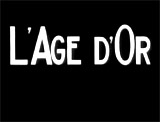

L'Age D'Or (1930, Fr.) (aka The Age of Gold, or The Golden Age), 60 minutes, D: Luis Buñuel
This was Buñuel's follow-up film to the previous year's short Un Chien Andalou (1929), and was his first feature film. At the time of its showing, this surrealistic, disjointed historically-significant Buñuel film (co-scripted by Salvador Dali) was denounced by the Roman Catholic Church (for a blasphemous castle orgy scene involving a Jesus Christ look-alike rapist), censored or banned by a few governments, sparked riots in theaters, and was considered controversial (pornographic and offensive). The plot was about two passionate yet frustrated lovers, a Man (Gaston Modot), a Goodwill Society delegate, and Young Girl (Lya Lys), a high-society heiress, kept from one another and repressed by the pious bourgeois establishment for fear of them having sex together. Two of its most indelible images were of the lovers in mud attempting to have sex with each other during a cornerstone ceremony performed to celebrate the founding of Imperial Rome, the two lovers expressing their erotic impulses by sucking each other's hands, and of the sexually-frustrated woman performing fellatio on the toes of a religious marble statue in a garden. The opening documentary sequence featured scorpions. Other images were of mitred chanting archbishops perched on coastal rocks who turned skeletal, a milking cow in a young woman's bed, an ox-cart driven by a horse through an elegant drawing room by two drunken peasants, some acts of violence (a dog kicked, a beetle stomped and squished on rocks, a blind man pushed down with a foot to his stomach, a foot crushing a violin on pavement, a punch in the face, the shooting of a young boy by his father - the groundskeeper), and bugs crawling over a party host's face; and most surprisingly, a burning tree, a bishop, a huge wooden plow, the bishop's staff, a giraffe statue, and pillow feathers thrown out of a window by the enraged Man. In the heretical ending, bearded and robed Duke of Blangis (Lionel Salem), a Jesus look-alike, raped a young woman in a castle during 120 days of debauchery, then emerged (without his beard) near a crucifix adorned with five female scalps blowing in the wind.



All Quiet on the Western Front (1930), 131 minutes, D: Lewis Milestone
A powerful, grim and poignant masterpiece. Based on the anti-war, pacifistic novel by Erich Maria Remarque and one of the best anti-war films, although technically dated. Best Picture award winning epic film that was shot with a budget of $1.25 million. Although it won the Academy Award for Best Picture, it was criticized as being propagandistic and anti-militaristic. For its perceived anti-German message, it was denounced by the Nazi government in Berlin of the 30s and subsequently banned there. It was about the experiences of a group of young, patriotic, German schoolboys during World War I. They volunteered to serve their country in 1914, fighting in the trenches on the Western Front battlefields, quickly finding that their illusions of glory were shattered. With innovative uses of a giant crane to provide sweeping views.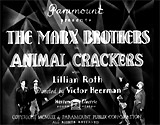


Animal Crackers (1930), 98 minutes, D: Victor Heerman
The second Marx Brothers film, somewhat stagy. Another zany, rapid-fire, anarchic hit based upon their Broadway hit play (by Morrie Ryskind and George S. Kaufman). It was the last of their films to be taken from one of their stage successes and the last to be filmed on the East Coast on Astoria sound stages before they transferred to Hollywood. A valuable painting had disappeared from the sprawling estate home of wealthy dowager Mrs. Rittenhouse (Margaret Dumont), and African big-game hunter Captain Spaulding (Groucho Marx) ("Hooray for Captain Spaulding") was called upon to find it, along with Chico, Zeppo and Harpo.

Anna Christie (1930), 86 minutes, D: Clarence Brown
A film adaptation of Eugene O'Neill's play. One of the earliest talkies, noted as the film in which silent star Greta Garbo first spoke. Her first line of dialogue: "Gimme a viskey..." Garbo played an alcoholic ex-prostitute who returned home from Minnesota to New York after a long absence to locate her barge captain father Chris Christofferson (George F. Marion), the alcoholic skipper of a coal barge, and found a sympathetic ear from gruff Marthy (Marie Dressler). She fell in love with strong Scottish seaman Matt (Charles Bickford), and had to tell him and her estranged father about her past.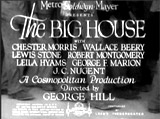

The Big House (1930), 84 minutes, D: George W. Hill
One of the earliest and most realistic of melodramatic prison pictures, used by many subsequent dramatic prison films as a model. It starred Wallace Beery as condemned prison inmate "Machine Gun" Butch Schmidt, a murderous cell-block leader. The grim prison was introduced when Kent Marlowe (Robert Montgomery) was sent to the prison for a ten-year sentence on vehicular manslaughter charges related to drunk driving, and was placed in a cell with two notorious prisoners: brutish Butch and John Morgan (Chester Morris), convicted of forgery and robbery. Things became far-fetched complicated when escaped prisoner Morgan fell in love with Marlowe's sister Anne (Leila Hyams), and then was recaptured and returned to the prison as a reformed man. The film's highlights included a jailbreak by angry prisoners led by Butch to escape from sadistic guards and overcrowded, inhumane conditions, and the subsequent bloody massacre.


The Blue Angel (1930, Germ.) (aka Der Blaue Engel), 99 minutes, D: Josef von Sternberg
Exotic German actress Marlene Dietrich's stardom was launched by von Sternberg's sexy drama, with her role as the leggy Lola Lola, a sensual cabaret striptease dancer, and her singing of "Falling in Love Again." It was Germany's first all-talking picture. Her performance in the first major German sound film led to a contract with Paramount in the US. The film told about a meek, authoritarian and repressed teacher Professor Immanuel Rath (Emil Jannings) who was tempted, seduced and destroyed by a sensual, carefree, and carnal top-hatted entertainer named Lola Lola Frohlich (Marlene Dietrich) at the Blue Angel nightclub in Weimar Germany - as he watched her. There, she sang a throaty rendition of "Falling in Love Again" astride a barrel on stage. She tilted her head to the side, leaned backwards, and grasped one gartered-stockinged leg on bare thighs with her arms. In her dressing room, the strait-laced Professor was seduced, charmed and humiliated by the cabaret singer - he knelt before her and was commanded to slip black stockings over her legs. Ultimately, he lost his teaching position and his dignity as he became obsessed and slavish to her.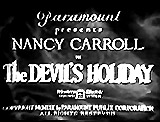

The Devil's Holiday (1930), 78 minutes, D: Edmund Goulding
A manipulative, flirtatious, gold-digging, big-city manicurist Hallie Hobart (Nancy Carroll) schemed to marry a millionaire's son David Stone (Phillips Holmes) from a family of wealthy wheat farmers, but was opposed by the young man's father Ezra Stone (Hobart Bosworth) and brother Mark (James Kirkwood). The country rube married her for all the wrong reasons, and continued to smother her with his love. Then, she offered to divorce him if given a fat payoff of $50,000. After leaving, her conscience began to take over and she took solace in parties and drink. Meanwhile, David was seriously ill as a result of a fall suffered in a fight over her with his brother. She returned to the side of her seriously-ill ex-husband, realizing she really loved him, and she also returned the $50,000.

The Divorcee (1930), 83 minutes, D: Robert A. Leonard
A melodrama that was regarded as hot and racy in its day. Jerry (Norma Shearer) married newspaperman Ted (Chester Morris), but then when he became a flirtatious philanderer with an ex-girlfriend, the recently divorced Janice (Mary Doran), Jerry decided to divorce him and live the adventurous single life as a wayward wife, matching his behavior. After a series of sexual escapades and two weeks on a yacht in the summer with married (but separated) former beau Paul (Conrad Nagel), she selflessly returned and was reconciled to her husband on New Year's Eve in Paris.

Earth (1930, Soviet Union) (aka Zemlya, or Земля), 75 minutes, D: Aleksandr Dovzhenko
An expressionistic, pro-collectivism propaganda story (a lyrical "film poem") about agricultural progress, and the class-warfare struggle between socialist peasants and villainous capitalist kulaks. It told about wealthy landowners (or kulaks) in the Ukraine who refused to give up land to a group of poor tenant-farming peasants, with the coming of collective farming. The collective farmers united to purchase a tractor, opposed by power-seeking landowners who disliked or felt threatened by any form of united front.



Hell's Angels (1930), 135 minutes, D: Howard Hawks, Luther Reed, James Whale
The legendary war film and aviation epic from mogul producer/director Howard Hughes, nominated for Best Cinematography. With sensational aerial photography and dogfight sequences. At $3.8 million, the most expensive film to date. Originally, it was to be a silent film, but Hughes discarded two years worth of footage (and its first leading lady Greta Nissen) and began filming again as a talkie in 1929. Two brothers, Monte (Ben Lyon) and Roy Rutledge (James Hall) left Oxford to join the British Royal Flying Corps and become fliers during World War I. Both brothers were rivals for the love of beautiful "Platinum Blonde", sexy siren Helen (an 18 year old Jean Harlow), who had fickle, two-timing affections - Harlow launched her career with the famous line: "Would you be shocked if I put on something more comfortable?" Most memorable wartime scenes: the beautifully photographed aerial dogfight skirmishes, German zeppelin raids over London, and the red-tinted and two-color Technicolor scenes.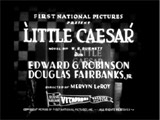


Little Caesar (1930), 79 minutes, D: Mervyn LeRoy
Considered as a milestone film that launched the first great cycle of the gangster film genre (from Warner Bros.), along with The Public Enemy (1931) and Scarface (1932). Cesare Enrico Bandello/"Little Caesar" (Edward G. Robinson in a great star-making performance that stereotyped him), a small-time, street-tough hood and merciless killer (based loosely on the career of Al Capone), rose to power at the top of the mob in the underworld, followed by a quick downfall. A fast-paced crime story, with lots of gunfire, robberies, killings, and implicit violence. Known for one of the most memorable closing lines in films, at Rico's death scene: "Mother of mercy, is this the end of Rico?"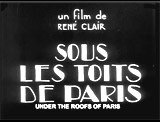




Under the Roofs of Paris (1930, Fr.) (aka Sous Les Toits de Paris), 96 minutes, D: René Clair
A bittersweet romantic comedy set in Paris - the first sound film and first French musical, from French director René Clair. The story told of a romance between poor street musician (singer and song-writer) Albert (Albert Préjean) and pretty, curly-haired, sensuous dream-girl - Romanian immigrant Pola (Pola Illéry). He met her when returning money to her, stolen by his pickpocket friend during his street-singing performance. The thief was a lecherous rogue and bullying petty gangster-thief named Fred (Gaston Modot). Another Pola admirer in a love triangle was Albert's inseparable, clever friend Louis (Edmond T. Gréville). In the meantime, Albert was wrongfully arrested and jailed for robbery, and sought to be hastily released so he could declare his true love for Pola in the bittersweet ending - and have her join him in a duo-singing act.